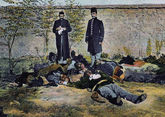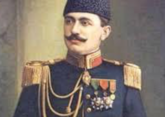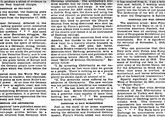March 31 marked the centenary of the 1918 tragic events in Baku and the Baku province - Day of the genocide of Azerbaijanis. Azerbaijani President Ilham Aliyev's decree on the events dedicated to this event says that during various stages of history Armenian nationalists carried out ethnic cleansing, deportations and genocide in order to realize the mythical idea of 'Great Armenia'. One of the most monstrous tragedy committed against the Azerbaijani people was the massacre, committed with extreme cruelty 100 years ago - in March-April 1918 - by Dashnak-Bolshevik armed groups operating under the mandate of the Baku Council.
The senior researcher of the Institute of Slavic Studies of the Russian Academy of Sciences, candidate of historical sciences Ilgar Mammadov explained that those events became both a continuation of the previous criminal policy and the beginning of the future one, in particular, in Khojaly.
"In the mid-1850s, European and American missionaries started their work in the Ottoman Empire with Armenians, which had extremely devastating consequences. Britain and the United States sponsored Protestants, France and Austria - Catholics. Britain used Armenian Protestants to protect their interests in India and Russia. French used Armenian Catholics to promote their own interests in the Middle East. Western powers, under the guise of protecting the religious rights of Armenians, tried to seize part of the Ottoman Empire's territory."
The historian recalled that a peace settlement was signed in Turkey's San Stefano between Russia and the Ottoman Empire in 1878, which ended the Russian-Turkish war of 1877-1878, and a few months later an international congress was held in Berlin, aimed at revising the Treaty of San Stefano. The congress ratified the Treaty of Berlin, Article 61 of which called on the Ottoman government to carry out reforms in the provinces inhabited by Armenians. "Control over the implementation of reforms was transferred to Russia, as well as to five European powers - Austria-Hungary, Britain, Germany, Italy and France. The Armenian factor was used by the European powers to exert pressure on the Ottoman Empire to make it more compliant in other issues. The Armenian factor was also used to exert pressure on Russia in order to prevent the strengthening of its influence in the region.The contradictions of the great powers, generated by the Congress of Berlin's decision, created high hopes in the Armenian nationalist circles for help from the European powers, especially Britain. Turning away from Russia, the Armenian nationalists started to tilt toward the European powers. However, the Europeans' were almost no longer required Armenian nationalists after the Congress of Berlin. At that time, Britain has already limited Russia's influence on Middle East politics, and the British gained access to Cyprus from the Ottoman government in exchange for an obligation to protect the Ottoman Empire from Russia," Ilgar Mammadov said.

According to him, after the Congress of Berlin the Hunchakian and Dashnaktsutyun parties were created to "solve the Armenian issue": "These parties wanted to create independent Armenia within the territory of six eastern provinces of the Ottoman Empire and the Transcaucasian territories of the Russian Empire. In the 1890s, the Armenian nationalists carried out a number of terrorist acts in the Ottoman Empire to expel the local population from the territory of those provinces they claimed. In addition, Armenian nationalists through the use of violence and terror against the Turks and the Kurds tried to provoke them to retaliate in order to attract the attention of Europeans. But Europeans, who used Armenians and already achieved their goals, have left the game."
According to Mammadov, not having achieved their goals in Anatolia, the Armenian nationalists, using the rise of the national movement in Russia, started subversive activities in the South Caucasus at the beginning of the 20th century: "Tragic events started on February 6, 1905 in Baku and soon spread to other regions where both the Armenian and Azerbaijani populations were living. Nagorno-Karabakh was the scene of fighting. The total number of casualties was from 3000 to 10,000 people. After the 1917 October Revolution, Baku found itself in the hands of the Baku Council, which was later led by Stepan Shaumyan, who actively collaborated with the Dashnaktsutyun Party. The Council units, largely consisting of Armenian soldiers who deserted from the front, committed massacres in the Baku district in March 1918. On March 31, more than 30 thousand civilians were killed in Baku alone. Shahumyan said about it: "We had armed forces of about 60 thousand people. Dashnaktsutyun also had 3-4 thousand of the national units that were at our disposal. The participation of the latter gave the civil war a character of national massacre. We did it deliberately." The massacres were continued in Shamakhi, Guba, Lankaran and other parts of Azerbaijan. In total in March-April 1918, Armenian armed people killed more than 50,000 Azerbaijanis, Russians, Jews and Georgians."
In 1919, the Armenian part of Karabakh officially recognized the power of Azerbaijan. This recognition was fixed in the agreement between the government of Azerbaijan and the Armenians of Karabakh. In 1919, the Karabakh general-governorate was established under the jurisdiction of the Azerbaijan Democratic Republic with the center in Shusha and under the leadership of governor Khosrov bey Sultanov. It was recognized as the only legitimate authority in this region. In the same year, the Armenian National Council was forced to abandon plans to join Karabakh to Armenia and recognize the jurisdiction of the ADR. The delegation of the Armenians of Karabakh during the meeting with chairman of the Council of Ministers of the ADR, Nasib-bek Usubbekov, in Baku expressed gratitude to the government of Azerbaijan for the peaceful resolution of the Karabakh problem.
Robert Scotland Liddell, British reporter who visited Karabakh, wrote that the region was peaceful as never before, according to the residents. He wrote from Shusha to London: "The Armenians agreed to submit to the Azerbaijani government. The Armenians said that they had never seen such an order in Shusha and Karabakh. Both people were ready to continue live peacefully and would have done so, if not for the intervention of the agitators. I am convinced that they are responsible for the Armenian-Azerbaijani massacre in Transcaucasia. The Armenian propagandists do their work deliberately, but I am convinced that their activity in Transcaucasia is a pure provocation. "
According to Mammadov, "external support was of key importance for the emergence of the Armenian issue. To carry out their terrorist actions, Armenian nationalists cooperated not only with the tsarist authorities, but also with their opponents - the Bolsheviks. Attempts to have it both ways continue to take place. The memory about it is a pledge that this will not happen again in the future. After 100 years we remember those who fell victim to inhumanity, terror and genocide. May the memory of them live forever."










